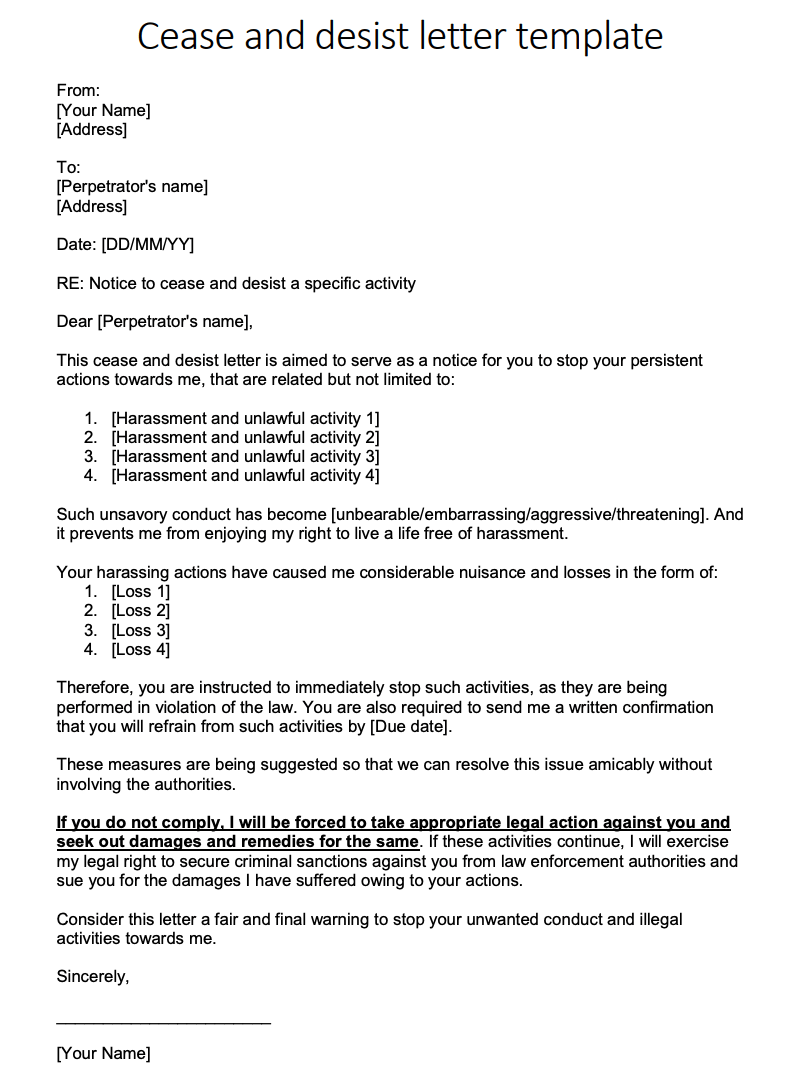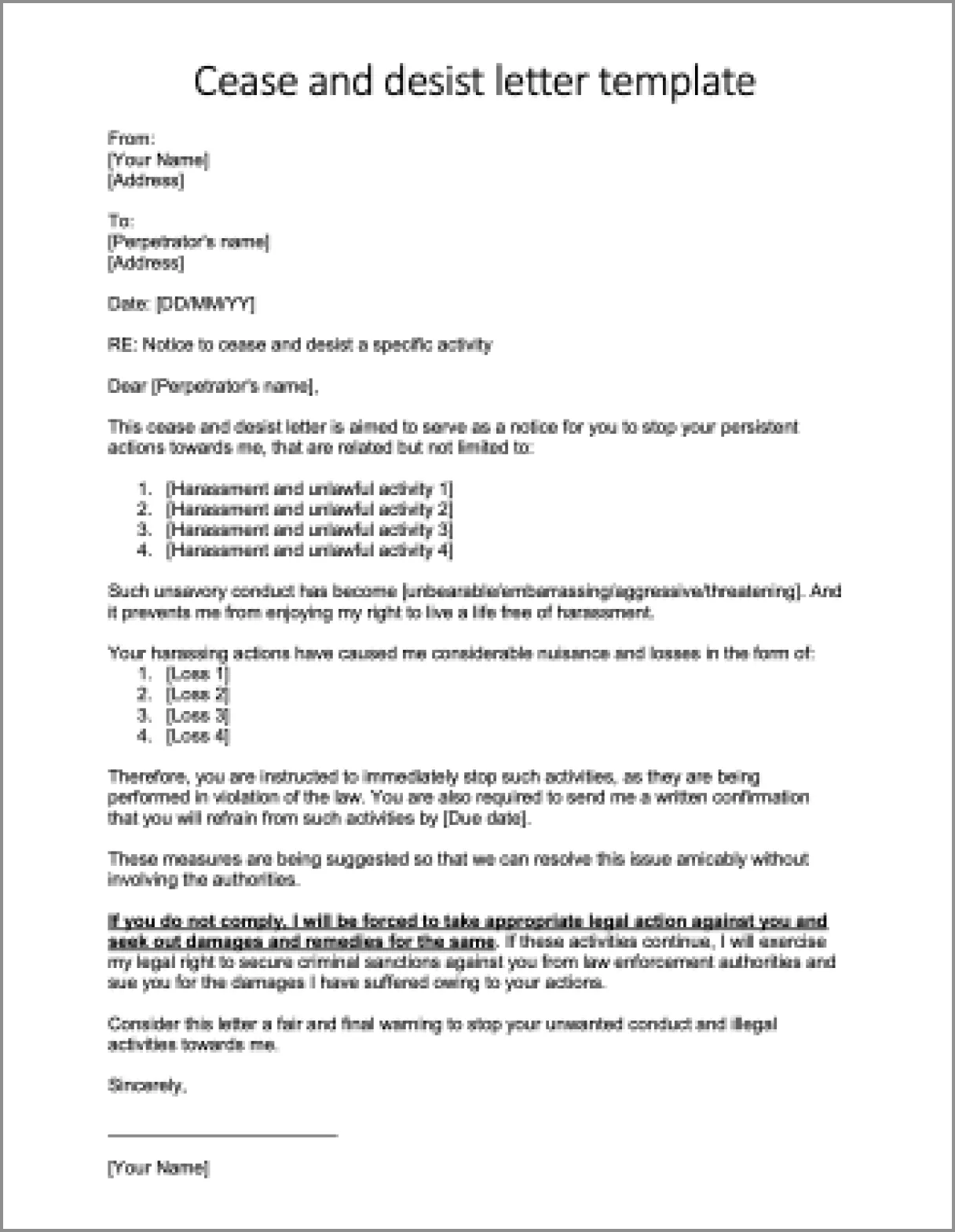Cease and Desist Letter Template
Need to put a stop to harassment, defamation, or other unwelcome behavior? A cease and desist letter template provides a formal way to demand that someone stop their harmful actions before you pursue legal action. This written notice warns the offender to cease their behavior immediately and desist from repeating it in the future.
Signeasy offers a free, customizable cease and desist letter template that you can download, fill out, and send electronically in minutes. Whether you are dealing with a harassing neighbor, aggressive debt collectors, or someone infringing on your intellectual property, this template provides the structure you need to protect your rights.

What is a cease and desist letter?
A cease and desist letter is a formal document sent to an individual or organization demanding they stop a specific action that is causing harm. The letter serves as a written warning before legal action and creates a record that you attempted to resolve the matter outside of court.
While a cease and desist letter is not legally binding on its own, it demonstrates that you are serious about protecting your rights. If the recipient ignores the letter and continues their behavior, you can use it as evidence in court to show that they were formally notified and chose not to comply.
Important distinction: A cease and desist letter is a warning you send yourself, while a cease and desist order is an official court injunction with legal enforcement power. You do not need a lawyer to write and send a cease and desist letter.
When to use a cease and desist letter
Cease and desist letters are commonly used in situations involving:
- Harassment: Unwanted contact, threats, stalking, or intimidating behavior from individuals or businesses
- Defamation: False statements that damage your reputation, whether spoken (slander) or written (libel)
- Debt collection abuse: Excessive or illegal contact from debt collectors
- Intellectual property infringement: Unauthorized use of your trademark, copyright, or patent
- Contract violations: Breach of an NDA, non-compete agreement, or other contractual obligation
Cease and desist letter for harassment
A cease and desist harassment letter template is specifically designed for situations where someone is engaging in unwanted, threatening, or intimidating behavior toward you. This could include a neighbor who repeatedly trespasses on your property, an ex-partner who will not stop contacting you, or a colleague engaging in workplace harassment.
When writing a cease and desist letter for harassment, be specific about the unwanted behavior. Document dates, times, and descriptions of each incident. This creates a clear record that can support your case if you need to pursue a restraining order or other legal action later.
Cease and desist debt collection letter template
Under the Fair Debt Collection Practices Act (FDCPA), you have the right to send a cease and desist letter to debt collectors demanding they stop contacting you. Once they receive your letter, they can only contact you to confirm they will stop or to inform you of specific legal actions they plan to take.
A cease and desist debt collection letter template should clearly state that you are invoking your rights under the FDCPA and demand that all phone calls, letters, and other forms of contact cease immediately. Keep in mind that this does not erase the debt — it only stops the collection attempts through that particular agency.
How to write a cease and desist letter
Follow these steps to create an effective cease and desist letter:
1. Include sender and recipient information
Start with your full name, address, and contact details. Then include the recipient's name and address. Add the date the letter is being sent.
2. Write a clear subject line
State the purpose of the letter directly, such as "Cease and Desist – Harassment" or "Notice to Cease and Desist – Copyright Infringement."
3. Describe the offensive behavior
Be specific and factual about what the recipient has done. Include dates, times, and locations when possible. Avoid emotional language and stick to the facts.
4. Explain the harm caused
Describe the mental, physical, financial, or reputational harm their actions have caused you. Quantifying damages adds credibility to your claims.
5. State your demands clearly
Demand that the recipient stop the behavior immediately. Set a deadline for compliance, typically 5-10 business days. Request written confirmation that they will cease the activity.
6. Warn of legal consequences
State that you will pursue legal action if they do not comply. Mention specific remedies you may seek, such as injunctive relief or monetary damages.
7. Sign and send the letter
Sign the letter to make it official. You can use an electronic signature to sign and send the document digitally, or send it via certified mail with return receipt to create proof of delivery.
What to include in your cease and desist letter template
A complete cease and desist letter example should include the following sections:
- Party identification: Full names and contact details for both sender and recipient
- Date: When the letter is sent
- Description of offending activity: Specific, factual account of the harmful behavior
- Supporting evidence: References to proof such as recordings, photos, or messages
- Reference to relevant laws: Applicable statutes or agreements being violated
- Demands: Clear statement of what the recipient must do or stop doing
- Compliance deadline: Timeframe for the recipient to respond (typically 5-10 business days)
- Legal consequences: Warning of actions you will take if they do not comply
- Signature: Your signature making the letter official
Cease and desist letter vs. cease and desist order
Understanding the difference between these two documents is important:
How to send a cease and desist letter
You can send a cease and desist letter through several methods. Certified mail with return receipt is the traditional approach, providing proof that the letter was delivered and signed for. However, electronic delivery through a platform like Signeasy offers faster delivery with a complete audit trail.
Signeasy's secure document delivery creates a timestamped record of when the document was sent and viewed, which can serve as evidence that the recipient received your notice. This eliminates the need for printing, mailing, and waiting for postal delivery.
Signeasy eSignatures for cease and desist letter template
Signeasy is an eSignature platform that offers a quick and easy paperless solution for creating and sending cease and desist letters. Furthermore, we ensure that each document is secure and legally binding.
Here are some of the other features Signeasy offers to streamline the signing and sharing process:
- Remotely sign and send the letter: It’s a pain to deal with printers, scanners, copiers, and courier agencies. Why not go paperless with Signeasy instead? Our software allows you to edit and send letters online in a matter of minutes! Plus, you can avoid any in-person contact with your harasser.
- Track receipt of letter: In case you choose to file a lawsuit at a later date, the cease and desist letter that you send now will be admissible in a court of law if you can prove that it was successfully delivered to the recipient. Usually, such letters are sent as certified mail with a return receipt, but Signeasy’s audit trail makes it even easier to confirm that the perpetrator received the letter at their email address.
- Reuse document templates: The ability to store and use templates on Signeasy is one of the solution’s biggest benefits. The ability to upload a cease and desist letter template, adjust the content, and send it to different recipients makes the entire process significantly more time-efficient.
- Comply with global eSignature legislation: Documents completed with Signeasy comply with the ESIGN Act and eIDAS. This cease and desist letter can therefore be presented as evidence in any court of law to show that you formally requested the perpetrator to cease their unlawful activities.
If you need to send out a letter like this one, give Signeasy’s free demo a shot. We can show you how to sign and manage a cease and desist letter template and so much more!
Download your free cease and desist letter template
Ready to send a cease and desist letter? Download Signeasy's free cease and desist letter template and customize it for your specific situation. Our template includes all the essential sections and can be signed and sent electronically within minutes.
With Signeasy, you can create a professional cease and desist letter, add your electronic signature, and deliver it instantly with a complete audit trail. No printing, no mailing, no delays - just a fast, secure way to formally demand that someone stop their harmful behavior.
Take the first step toward protecting your rights today. Download the template, customize it with your specific details, and send it with confidence knowing you have a documented record of your formal notice.
Template Preview
